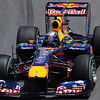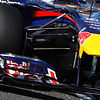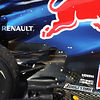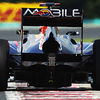Analysis: Red Bull launch RB6


Red Bull Racing have introduced their new 2010 car, the Red Bull RB6. As it was the leading car at the end of 2009, the RB5 has just been evolved. The new car retains the rear pull rod suspension, the V-nose and the shark fin connected to the rear wing.
The new car is not the revolution that many hoped for and hence looks very similar to its predecessor.
At the front, a new wing is likely to be introduced before the start of the season. The current version is similar to that of the RB5. The stacked elements are slightly changed as the tips are now rounded to reduce wingtip vortices. The front wing endplates are the most simple we have yet seen on any of the launched cars. It really are simple panels that are sharply curved ahead of the front tyres.
The nose cone has been made a little bit wider but still features the rounded bottom, while at the top two ears are still present, albeit made slightly shorter. These hubs are still used to host the rockers for the front suspension's push rods. The team did however choose to relocate the steering arms, now a little bit lower than before.
Interesting about the nose are the small strips added to each side of the nose ahead of the front suspension arms. Adrian Newey clearly got his mustard here from the Brawn BGP001.
The frontal area of the sidepods has also largely been left unchanged, with the cooling entries looking similar to last year's. The barge boards now have a jagged edge, while the mirrors are positioned on the sidepod panels, just like most other teams have also done.
Despite putting in a much larger fuel tank, the sidepods are still heavily undercut. It can be considered a real achievement that visually most components behind the driver's head have been carried over from the successful Red Bull RB5.
The rear diffuser is also a point of interest where much time can be gained this year. Red Bull already had a high crash structure and the concept has been deepened. The rear light is now higher than before and fixed on the crash structure that runs up at 45°. Around it is the new diffuser, featuring curves similar to a diffuser version McLaren ran in 2009.







